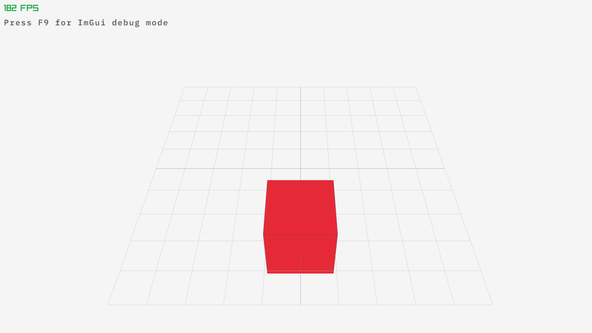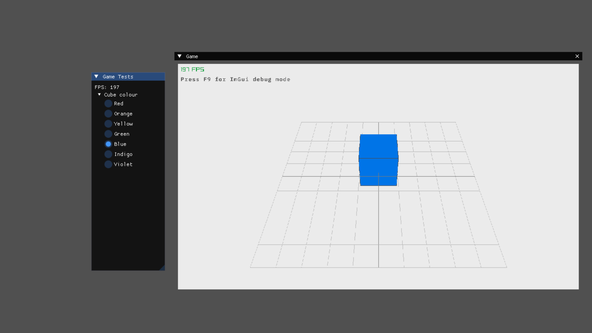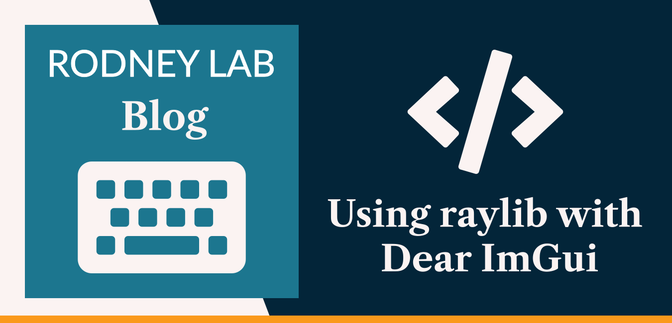🖥️ Dear ImGui as a raylib Debugging Interface #
Here, we will look at using raylib with Dear ImGui. Dear ImGui is a C++ immediate mode GUI library, helpful for creating using interfaces in game development, or standalone apps. We see how you might create a basic debugging interface for your raylib game, using Dear ImGui.
Printing debug message to the console, can be a useful first step in debugging, and libraries like dbg macro, spdlog and fmtlib will help you here. However, for real-time app data or even updating game state while the game is running, something like Dear ImGui will provide a more powerful interface.
In this post, using CMake, we set up a basic raylib app, with a Dear ImGui powered debug mode. In the real world, the debugging interface might be used for game entity introspection as well as updating game state. Here, we keep things simple, to demonstrate the concept. We change the colour of a rendered cube while the game is running, using radio buttons in our Dear ImGui debug window.
🧱 What we’re Building #

The app with have a main view, which is the way the typical end-user will interact with it. The app will also have a debug view. This will contain a scaled-down version of the main view, to make space for the Dear ImGui debug interface.

Project CMake File #
I like using CMake for C++ projects, as it offers a convenient way to handle project dependencies. It is also great for cross-platform projects and integrates well with CI tooling, such as GitHub Actions.
1 cmake_minimum_required(VERSION 3.16)2 project(RaylibImGui LANGUAGES C CXX)3 4 set(CMAKE_RUNTIME_OUTPUT_DIRECTORY ${CMAKE_BINARY_DIR}/bin)5 set(CMAKE_EXPORT_COMPILE_COMMANDS True)6 add_library(raylib_imgui_compiler_flags INTERFACE)7 target_compile_features(raylib_imgui_compiler_flags INTERFACE cxx_std_17)8 option(BUILD_SHARED_LIBS "Build shared libraries" OFF)9 10 set(gcc_like_cxx "$<COMPILE_LANG_AND_ID:CXX,ARMClang,AppleClang,Clang,GNU,LCC>")11 set(msvc_cxx "$<COMPILE_LANG_AND_ID:CXX,MSVC>")12 target_compile_options(13 raylib_imgui_compiler_flags14 INTERFACE15 "$<${gcc_like_cxx}:$<BUILD_INTERFACE:-pedantic-errors;-Werror;-Wall;-Weffc++;-Wextra;-Wconversion;-Wsign-conversion>>"16 "$<${msvc_cxx}:$<BUILD_INTERFACE:-W4>>")17 18 include(cmake/StaticAnalysers.cmake)19 enable_clang_tidy()20 21 set(CMAKE_MODULE_PATH "${CMAKE_MODULE_PATH};${PROJECT_SOURCE_DIR}/cmake")22 23 include(Dependencies.cmake)24 raylib_imgui_setup_dependencies()25 26 add_executable(RaylibImGuiApp src/main.cpp src/game/game.cpp)27 set_target_properties(RaylibImGuiApp PROPERTIES CXX_CLANG_TIDY28 "${CLANG_TIDY_COMMAND}")29 target_link_libraries(30 RaylibImGuiApp31 PUBLIC dbg_macro32 fmt33 imgui34 raylib35 rlimgui36 spdlog::spdlog_header_only37 raylib_imgui_compiler_flags)38 target_compile_definitions(RaylibImGuiApp PRIVATE SPDLOG_FMT_EXTERNAL)39 target_compile_definitions(40 RaylibImGuiApp PUBLIC ASSETS_PATH="${CMAKE_CURRENT_SOURCE_DIR}/assets/")41 target_include_directories(RaylibImGuiApp PUBLIC "${PROJECT_SOURCE_DIR}/src")
-
We include the dependencies in a separate CMake file (
23-24). -
SPDLOG_FMT_EXTERNAL(line38) can help avoid compile errors when using fmtlib and spdlog in the same project (spdlog will look for an external fmtlib library, instead of building its own). -
Defining
ASSETS_PATHhere makes it easier to like the font TTF loaded in C++ code.
In your C++ code which needs a link to an asset path, you can write something like this:
const Font font{LoadFont(ASSETS_PATH "ibm-plex-mono-v19-latin-500.ttf")};
Remembering to place the asset file in the project assets folder, matching the path written in the CMakeLists.txt file.
There is a link to the full project code further down the page, in case you
want to explore anything here in detail. Let’s have a quick look at that
dependencies file, next, before opening up main.cpp.
👪 CMake Dependencies #
We use rlImGui to add Dear ImGui to the raylib project . On top, we have some C++ utility libraries (dbg-macro, fmtlib, and spdlog).
CPM is a marvellous tool for handling dependencies in CMake. It is essentially
a convenient wrapper for the CMake FetchContent module, and comes with handy caching capabilities too.
I use CPM here for libraries which I do not need to build manually. For Dear
ImGui and rlImGui, I use the CMake FetchContent module. This is just because I have caching switched on for CPM, and the source
files are saved outside the project (they are shared between all local projects).
FetchContent, on the other hand, places the
source files within the project directory, helpful for manual library
building.
1 include(cmake/CPM.cmake)2 3 function(raylib_imgui_setup_dependencies)4 message(STATUS "Include Dear ImGui")5 FetchContent_Declare(6 ImGui7 GIT_REPOSITORY https://github.com/ocornut/imgui8 GIT_TAG cb16be3a3fc1f9cd146ae24d52b615f8a05fa93d) # v1.90.99 10 FetchContent_MakeAvailable(ImGui)11 FetchContent_GetProperties(ImGui SOURCE_DIR IMGUI_DIR)12 13 add_library(14 imgui STATIC15 ${imgui_SOURCE_DIR}/imgui.cpp16 ${imgui_SOURCE_DIR}/imgui_draw.cpp17 ${imgui_SOURCE_DIR}/imgui_widgets.cpp18 ${imgui_SOURCE_DIR}/imgui_tables.cpp)19 target_include_directories(imgui INTERFACE ${imgui_SOURCE_DIR})20 21 include(cmake/CPM.cmake)22 23 message(STATUS "Include dbg-macro")24 cpmaddpackage(25 "gh:sharkdp/dbg-macro#fb9976f410f8b29105818b20278cd0be0e853fe8"26 )# v0.5.127 28 message(STATUS "Include fmtlib")29 cpmaddpackage("gh:fmtlib/fmt#0c9fce2ffefecfdce794e1859584e25877b7b592"30 )# 11.0.231 32 message(STATUS "Include raylib")33 cpmaddpackage("gh:raysan5/raylib#ae50bfa2cc569c0f8d5bc4315d39db64005b1b0"34 )# v5.035 36 message(STATUS "Include spdlog")37 cpmaddpackage("gh:gabime/spdlog#27cb4c76708608465c413f6d0e6b8d99a4d84302"38 )# v1.14.139 40 message(STATUS "Include rlImGui")41 FetchContent_Declare(42 rlImGui43 GIT_REPOSITORY https://github.com/raylib-extras/rlImGui44 GIT_TAG d765c1ef3d37cf939f88aaa272a59a2713d654c9)45 FetchContent_MakeAvailable(rlImGui)46 FetchContent_GetProperties(rlImGui SOURCE_DIR RLIMGUI_DIR)47 48 add_library(rlimgui STATIC ${rlimgui_SOURCE_DIR}/rlImgui.cpp)49 target_link_libraries(rlimgui PRIVATE imgui raylib)50 target_include_directories(rlimgui INTERFACE ${rlimgui_SOURCE_DIR})51 endfunction()
I like to pin GitHub dependencies using a commit hash, instead of a tag. You need a recent CPM.cmake file in your project for CPM to work.
Using raylib on Windows with spdlog #
If you are running raylib on Windows and include spdlog in a C++ source file
that uses raylib, you might get a duplicate definition compile error. I
spotted this running a game build in CI using GitHub Actions. The issue stems
from raylib having a windows.h file, also used by
spdlog. There are a few known workarounds mentioned in this GitHub issue.
Including raylib.h and spdlog/spdlog.h in this order and adding the preprocessor macros worked for me:
// Windows workarounds for CloseWindow / ShowCursor errors #if defined(_WIN32)#define NOGDI // All GDI defines and routines#define NOUSER // All USER defines and routines#endif #include <fmt/core.h>#include <spdlog/spdlog.h> #undef near#undef far #include <raylib.h>
♟️ C++ Time: Main Game Loop #
The easiest way to learn raylib is probably to scan through the raylib examples for something that resembles what you need, and using that as your launch point. The other fantastic resource is the raylib cheat sheet (also available as a PDF from that same page). Once you know which function to use, you can pop open the source in your code editor to check how to use it.
I created this demo by merging the 3D Camera Mode example and an external CMake / raylib / rlImgui / imgui example on GitHub by nosqd .
raylib Textures #
Please enable JavaScript to watch the video 📼
Textures, in raylib are typically used to paint an external image within the game window. We will use textures here in the debug view. One texture for the scaled-down main view, and another for the Dear ImGui debug interface.
We can use rectangles to define the bounds and mapping for the main window texture:
46 RenderTexture gameTexture;47 gameTexture = LoadRenderTexture(static_cast<int>(windowSize.x),48 static_cast<int>(windowSize.y));49 constexpr float kDebugScaleUp{1.5F};50 debugTexture =51 LoadRenderTexture(static_cast<int>(windowSize.x / kDebugScaleUp),52 static_cast<int>(windowSize.y / kDebugScaleUp));53 54 const Rectangle source_rectangle{0, // top-left x55 -windowSize.y, // top-left y56 windowSize.x, // width57 -windowSize.y}; // height58 const Rectangle destination_rectangle{0,59 0,60 windowSize.x / kDebugScaleUp,61 windowSize.y / kDebugScaleUp};
This code is adapted from the nosqd repo mentioned, above.
Then, to draw the scaled-down main window, in debug mode:
106 BeginTextureMode(debugTexture);107 DrawTexturePro(gameTexture.texture,108 source_rectangle,109 destination_rectangle,110 {0, 0}, // origin111 0.F, // rotation112 RAYWHITE); // tint113 EndTextureMode();
🎨 Creating Dear ImGui Interfaces #
Dear ImGui is extremely versatile, with many in-built components. You can style it, though, so probably the only Dear ImGui criticism you will have is that it does not look fantastic out-of-the box. For a debugging user interface, I think it is marvellous (even without adding styling).
Because there are so many components, to get an idea of what it can do, and also how to do it, you should see the Dear ImGui Online Manual created by Pascal Thomet . That site is kind of a breakfast buffet of all the Dear ImGui components. You can hover over a component to see the C++ source needed to create it.
As it happens, the radio button code, for selecting colour, is quite straight-forward:
64 ImGui::Begin("Game Debug");65 66 ImGui::Text("%s",67 fmt::format("FPS: {}", GetFPS()).c_str());68 69 if (ImGui::TreeNode("Cube colour"))70 {71 int index{0};72 for (const std::string &colour : constants::kCubeColourLabels)73 {74 ImGui::RadioButton(colour.c_str(), &selected_cube_colour, index);75 ++index;76 }77 }78 ImGui::End();
selected_cube_colour is an integer, which Dear ImGui
will update to match the index of the selected radio button.
Main code structure #
int main(){ SetWindowState(FLAG_MSAA_4X_HINT); InitWindow(static_cast<int>(windowSize.x), static_cast<int>(windowSize.y), constants::kTitle.c_str()); rlImGuiSetup(true); /* Game Texture code (as above) */ RenderTexture gameTexture; // TRUNCATED... while (!WindowShouldClose()) { BeginDrawing(); rlImGuiBegin(); ClearBackground(DARKGRAY); if (debugMenu) { // Create the main window texture BeginTextureMode(gameTexture); ClearBackground(RAYWHITE); draw_scene(camera, cube_position, constants::kCubeColours[static_cast<size_t>( selected_cube_colour)], font); EndTextureMode(); // Create the debug panel texture BeginTextureMode(debugTexture); DrawTexturePro(gameTexture.texture, source_rectangle, destination_rectangle, {0, 0}, 0.F, RAYWHITE); EndTextureMode(); // draw the debug panel ImGui::Begin("Game Debug"); ImGui::Text("%s", // NOLINT [cppcoreguidelines-pro-type-vararg] fmt::format("FPS: {}", GetFPS()).c_str()); // TRUNCATED... ImGui::End(); // Place the debug texture within the panel ImGui::Begin( "Game", &debugMenu, static_cast<uint8_t>( ImGuiWindowFlags_AlwaysAutoResize) | static_cast<uint8_t>(ImGuiWindowFlags_NoResize) | static_cast<uint8_t>(ImGuiWindowFlags_NoBackground)); rlImGuiImageRenderTexture(&debugTexture); ImGui::End(); } else { // draw the main view — no need for textures for main view ClearBackground(RAYWHITE); draw_scene(camera, cube_position, constants::kCubeColours[static_cast<size_t>( selected_cube_colour)], font); } rlImGuiEnd(); EndDrawing(); }}
Code is simplified here to highlight the main steps. See the repo (like below) for full code demo.
🗳 Poll #
🙌🏽 Using raylib with Dear ImGui: Wrapping Up #
In this using raylib with Dear ImGui post, we had a look at the elements you need to add a debugging, developer tools or testing view to your raylib game using Dear ImGui. More specifically, we saw:
- CMake configuration for a raylib game running Dear ImGui;
- how to use textures in raylib; and
- setting up a C++ game loop in rlImGui with a debug mode.
I hope you found this useful. As promised, you can get the full project code on the Rodney Lab GitHub repo . We have looked at some raylib basics here, and you might also consider using the debug view to help learn raylib. For example, you could link ImGui widgets to the 3D camera parameters to get a grip on how these work. Do let me know how you use this code. Also reach out if there is anything I could improve to provide a better experience for you.
🙏🏽 Using raylib with Dear ImGui: Feedback #
If you have found this post useful, see links below for further related content on this site. Let me know if there are any ways I can improve on it. I hope you will use the code or starter in your own projects. Be sure to share your work on X, giving me a mention, so I can see what you did. Finally, be sure to let me know ideas for other short videos you would like to see. Read on to find ways to get in touch, further below. If you have found this post useful, even though you can only afford even a tiny contribution, please consider supporting me through Buy me a Coffee.
Just dropped a blog post on using raylib with Dear ImGui. I include:
— Rodney (@askRodney) April 1, 2024
— CMake dependency setup;
— dev mode texture setup and updating; and
— link to the full project code.
Hope you find it useful!
#askRodneyhttps://t.co/95bXHGwE9M
Finally, feel free to share the post on your social media accounts for all your followers who will find it useful. As well as leaving a comment below, you can get in touch via @askRodney on X (previously Twitter) and also, join the #rodney Element Matrix room. Also, see further ways to get in touch with Rodney Lab. I post regularly on Game Dev as well as Rust and C++ (among other topics). Also, subscribe to the newsletter to keep up-to-date with our latest projects.


